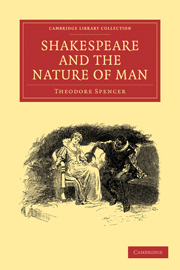Book contents
- Frontmatter
- Preface
- Contents
- SHAKESPEARE and THE NATURE OF MAN
- I Man in Nature: the Optimistic Theory
- II Man in Nature: the Renaissance Conflict
- III The Dramatic Convention and Shakespeare's Early Use of It
- IV Hamlet and Troilus and Cressida
- V Othello and King Lear
- VI Macbeth and Antony and Cleopatra
- VII Shakespeare's Last Plays
- VIII Literature and the Nature of Man
- Index
VI - Macbeth and Antony and Cleopatra
Published online by Cambridge University Press: 07 September 2010
- Frontmatter
- Preface
- Contents
- SHAKESPEARE and THE NATURE OF MAN
- I Man in Nature: the Optimistic Theory
- II Man in Nature: the Renaissance Conflict
- III The Dramatic Convention and Shakespeare's Early Use of It
- IV Hamlet and Troilus and Cressida
- V Othello and King Lear
- VI Macbeth and Antony and Cleopatra
- VII Shakespeare's Last Plays
- VIII Literature and the Nature of Man
- Index
Summary
One of the most remarkable things about Shakespeare is that although he uses the same materials for the achievement of size and universality in his great tragedies, he creates in each a distinctive and particular world. In Macbeth, as in King Lear, the individual, the state, and external nature are seen as interrelated parts of a single whole, so that a disturbance in one disturbs the others as well—and yet the atmosphere and tone of the two plays are very different; we may say that Lear is a play that opens out, whereas Macbeth is a play that closes in. Lear's sufferings end in release, but Macbeth, in the course of his career, becomes trapped by his own crimes, until he sees himself, at the end, as a captured animal:
They have tied me to a stake; I cannot fly,
But bear-like I must fight the course.
(v, 7, 1)In Macbeth there is nothing like the purgation of King Lear. As the action of King Lear progresses the main character loses his bad qualities; in the course of Macbeth, the main character develops them. This is something new. Iago, for example, does not become increasingly evil as the play goes on; he is thoroughly and completely bad from the beginning. But Macbeth grows into evil; that is why those critics are right who describe the play as a more intense study of evil than any other.
- Type
- Chapter
- Information
- Shakespeare and the Nature of Man , pp. 153 - 176Publisher: Cambridge University PressPrint publication year: 2009First published in: 1943



